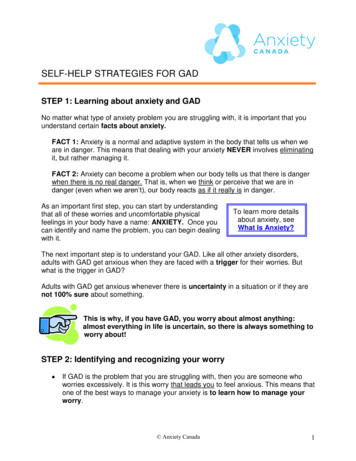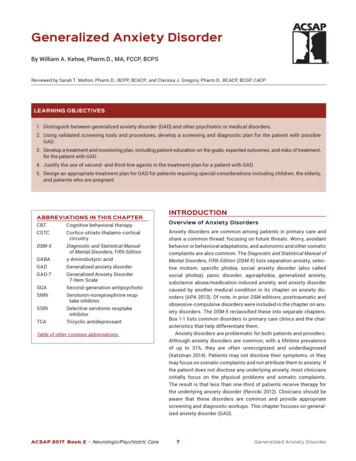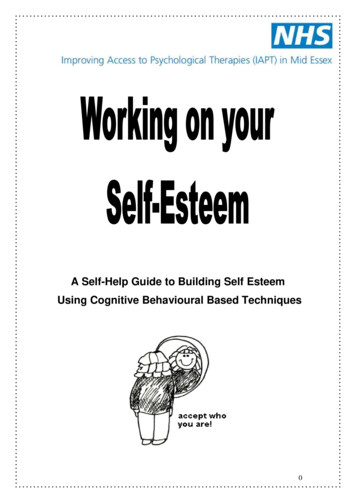
Transcription
SELF-HELP STRATEGIES FOR GADSTEP 1: Learning about anxiety and GADNo matter what type of anxiety problem you are struggling with, it is important that youunderstand certain facts about anxiety.FACT 1: Anxiety is a normal and adaptive system in the body that tells us when weare in danger. This means that dealing with your anxiety NEVER involves eliminatingit, but rather managing it.FACT 2: Anxiety can become a problem when our body tells us that there is dangerwhen there is no real danger. That is, when we think or perceive that we are indanger (even when we aren’t), our body reacts as if it really is in danger.As an important first step, you can start by understandingthat all of these worries and uncomfortable physicalfeelings in your body have a name: ANXIETY. Once youcan identify and name the problem, you can begin dealingwith it.To learn more detailsabout anxiety, seeWhat Is Anxiety?The next important step is to understand your GAD. Like all other anxiety disorders,adults with GAD get anxious when they are faced with a trigger for their worries. Butwhat is the trigger in GAD?Adults with GAD get anxious whenever there is uncertainty in a situation or if they arenot 100% sure about something.This is why, if you have GAD, you worry about almost anything:almost everything in life is uncertain, so there is always something toworry about!STEP 2: Identifying and recognizing your worryIf GAD is the problem that you are struggling with, then you are someone whoworries excessively. It is this worry that leads you to feel anxious. This means thatone of the best ways to manage your anxiety is to learn how to manage yourworry. Anxiety Canada1
To manage worry, you first need to become an expert at recognizing it. Youprobably think that you are already a “worry expert” since you do it everyday.However, when most adults are asked what they worried about during the week,they either can’t remember or they can only recall one or two “greatest hits” (mostcommon worries), and forget about the rest.The best way to start noticing and recognizing your worries is to begin recordingthem in a worry diary. Write down what you are worrying about at set times 2-3times a day, along with the trigger for your worry and your anxiety level.STEP 3: Classifying your worriesThere are two general types of worries:1. Worries about current problems (for example, “what if I don’t have enoughmoney to pay the bills?”, “what if I don’t finish my report on time?”, “what if myargument with my friend means we never speak again?”)2. Worries about hypothetical situations (for example, “what if the flight I’m takingnext month crashes?”; “what if I get a serious disease when I’m older?”)One of the main differences between these two types of worries is the amount ofcontrol you have over the situation:oWith worries about current problems, you have some direct control over thesituation. For example, you can manage your finances, work on your reportwriting, or resolve an argument with a friend.oWith worries about hypothetical situations, you have almost no control, so there isvery little, if anything, that you can do to change the situation. For example,unless you are the pilot, you have no control over how a flight will go, and youcannot control (beyond basic good health, exercise, and nutrition) whether youwill contract a serious disease years from now.Since these worry types are different, you need to manage them differently. A good wayto keep track of which type of worries you have is to classify your worries in the worrydiary as being either about current problems or hypothetical situations.REMEMBER: Many people with GAD are afraid thatrecording and classifying their worries will make their GADsymptoms worse. This is not true. You are simply becomingan expert at catching and recognizing your worries. Theyare already there, you are merely observing them withgreater attention. This is important if you want to be able tomanage your worries. Anxiety Canada2
STEP 4: Building your Worry Management ToolboxThe best way to begin managing your worry and anxiety is to start building a toolbox ofstrategies that you can use instead of worrying. The following is a list of tools that youcan use to manage GAD.Although the feeling of anxiety in GAD is due to your worries, it can be uncomfortable toexperience anxiety in the body. Therefore, these first two techniques are designed tohelp you to get a feeling of control over the anxiety in your body, and “turn the volumedown” on those anxious feelings.TOOL #1: Learning to calm anxiety by slowing down your breathingCalm breathing involves slowing down your breathing by breathing in deeplythrough your nose, and exhaling slowly through your mouth. It is a quick and easy wayto reduce some of the physical feelings of anxiety in the body.For more information, see How to do Calm BreathingTOOL #2: Learning how to calm your anxiety by relaxing the musclesin your bodyAnother helpful strategy involves learning to relax your body. This involves tensingvarious muscles and then relaxing them. This strategy can help to lower your overalltension and stress levels that can contribute to feelings of anxiety.For more information, see How to do Progressive Muscle RelaxationTOOL #3: Learning to become comfortable with uncertaintyResearch shows us that a major trigger for GAD worry is uncertainty.That is, whenever you are not 100% sure of something, you are likely to worryabout it. For example, if you aren’t sure of a decision (even a small one, likepicking a movie to watch), you are probably going to worry about it. The problemis that almost everything in life is uncertain because no one can predict the future.If the trigger is uncertainty, then the best way to deal with it is to learn to becomemore comfortable with it. The other option – trying to have 100% certainty – iswhat you are trying to accomplish when you worry. But you already know that thistactic is not very successful. If it were, you wouldn’t have a problem with worry! Anxiety Canada3
So how do you become comfortable with uncertainty? The best way to do this isby changing your behaviour to act “as if” you are comfortable with it. Examples ofthis strategy might be:o Not re-reading e-mails before sending themo Going to the grocery store without a listo Going to a new restaurant without reading areviewTIP: You will probablyfeel anxious when youtry these exercises.That is a sign that youare on the right track!o Completing a task at work without askingsomeone else to look it over and give their opinion on ito Delegating a task to someone else (and then not checking whether it wasdone correctly)For more information on how to increase your comfort with uncertainty, see How toTolerate Uncertainty.TOOL #4: Rethinking the usefulness of worryIf you have GAD, you probably realize that you are worrying too much, and thatthis is not a good thing. However, what most people with GAD don’t realize is that theyalso often believe that worry is actually useful or helpful.As long as you think that worrying is helpful or useful in some way,you are going to want to keep doing it.In order to help you manage your worry, it is important to recognize and rethink anybeliefs you might have about the usefulness of your worry. After all, your worries mightnot be as helpful as you think.What are the positive beliefs that people with GAD have about worry?1. Worrying shows that I am a caring person.If you believe this, you might think, “because I worry about my family, it proves that Ilove and care about them”, or “people know me as the worrier; I’m the one who worriesand cares for people”. Anxiety Canada4
2. Worrying helps me to be prepared and to problem solve.Examples of this belief include: “I do well at my job because I worry about things gettingdone right!”, and “when I worry about my problems, I am more likely to solve them well”.3. Worrying motivates me.If you believe this, then you might say to yourself, “worrying about my job motivates meto do well”, or “if I didn’t worry about my health, I would never go to the gym or eat right!”4. Worrying protects me from negative emotions.If you believe this, then you probably think that worrying about bad things is like “moneyin the bank”; that is, if you worry about bad things now, you won’t be so upset if the badthing actually happens. An example of this type of belief is, “If something bad happenedto my family and I didn’t worry about it, it would come as a surprise, and I wouldn’t beable to handle it”.5. Worrying prevents bad things from happening.If you have this belief, you might think, “I always do well at my job because I worry aboutit; if I stopped worrying for a day, I would do very badly at my job”, or “if I worry about myfamily being in a car accident, then they won’t be in one”.How can you rethink your worries?Trying to change your beliefs about the usefulness of worry is not as simple assaying “worry is bad”. In order for you to change your beliefs, you need to look atyour beliefs and think about whether your worries are doing what you thinkthey are doing.Here are some questions that you can ask yourself about the worries that youthink are helpful: Anxiety Canada5
Worry BeliefsQuestions to Help you Rethink Your BeliefsWorry shows that Iam a caring personDo I know caring people who don’t worry as much as I do?What else besides worry shows that I care?Worry helps me tobe preparedAm I confusing worrying (in my head) with actually doingsomething (for example, actually solving problems ratherthan worrying about them)?Do I know people who are organized and prepared whodon’t worry as much as I do?Worry motivates meAm I really more motivated when I worry?Has worrying ever actually prevented me from doing thethings I want to do? (for example, worrying so much aboutbeing healthy that you actually avoid the gym?)Worry protects mefrom negativeemotionsIf something bad did happen, would I really not be asupset?Has anything bad ever happened in my life? Did I really feelmore prepared to deal with it because I worried about it?Worry preventsnegative outcomesHas anything bad ever happened in my life even though Iworried about it?Is there a way that I can test out my theory, by worrying oneday and seeing what happens, and then not worryinganother day?Another way that you can rethink the usefulness of your worries is to ask yourself howmuch you have lost because of worrying. For example:Has worry affected my friendships or relationships with others? Are peopleannoyed with me for worrying?How much time, effort, and energy have I spent worrying? Is it worth it?How has worry affected me physically? Am I tense all the time, often tired, or do Ihave trouble sleeping because of my worries? Anxiety Canada6
If you find that your worries are not so helpful, that they are not doing what you thinkthey are, and that they have cost you a lot in your life, then you can choose to learn newskills to manage your worry.If you still believe that your worries can be helpful from time to time, ask yourselfthe following question: is it possible to gain the benefits I get from worrying in a wayother than through worry? For example, can I be a caring person and not worry? Can Ibe organized, prepared, and motivated without worrying all the time? If you think that itis possible to get the benefits without the worry, then you too can choose to learn newskills to manage your worry.TOOL #5: Improving your problem-solving abilityRemember when you started classifying your worries as being about currentproblems or hypothetical situations? One of the reasons you did this was because wemanage these two worry types differently.The best way to deal with worries about current problems is to use problem-solvingskills and solve the problem!Many people with GAD think that they are problem solving when they are worrying; infact, the opposite is usually true. That is, when you worry, you are going over a problemin your head but problem solving is active! It involves getting out of your head andcarrying out a solution. Often, when people with GAD worry about a problem they willget so anxious about the problem that they avoid actually solving it, or theyprocrastinate.Learning ways to improve your problem-solving ability will help you in two ways:1. You can start solving your problems, rather than worrying about them. Thiswill likely make you feel less anxious, and for every problem you solve, youhave one less thing to worry about.2. Because finding a solution to real-life problems almost always involves someuncertainty, you will also be learning to become more comfortable withuncertainty each time you use your problem-solving skills.For information on how to deal with worries aboutcurrent problems by using problem-solving skills,see How to Solve Daily Life Problems Anxiety Canada7
TOOL #6: Writing a worry scriptUnlike worries about current problems, using problem-solving skills is usuallynot very effective in dealing with worries about hypothetical situations. For example, noamount of problem solving will help you to deal with worries about developing a seriousillness later on in life.For these types of worries, the best technique is to write a worry script every day for aweek or two.What is a worry script?A worry script is like a journal entry, where you write about your worry, and what you areafraid will happen. For example, if you are afraid of developing a serious illness, youmight write in your worry script about how afraid you are of becoming sick, what you fearmight happen, such as being in a hospital, being forgotten or abandoned by family, andmissing out on all the great opportunities in life.What will a worry script do?Writing a worry script will help you to experience the negative emotions associated withyour fears and worries, rather than avoid them. Although this will feel uncomfortable atfirst, research shows us that when you face your fears in this way, your anxiety andworries will go down over time. A worry script also helps you to imagine what yourfeared outcome would actually look like, rather than thinking about it in “fuzzy”, “blurry”,or imprecise ways.For more information, see How to Write a Worry Script.REMEMBER: The only way to get over anxiety is to go straightthrough it! Most of these skills will probably make you feel more anxiouswhen you first try them. Whenever we try something new or different, weusually feel anxious. This does not mean that you are doing somethingwrong. It means that you are starting to face your fears and get over them.STEP 5: Building on braveryRemember that any progress you make in managing your worry and anxiety is due toyour own hard work. If you are noticing improvements, take the time to give yourselfsome credit: reward yourself!The best way to see your progress is to record all the work you do using your worrymanagement skills. For example, write down the problems you solved, and record Anxiety Canada8
whether you are worrying less about that topic afterward. If you have been practicingbecoming more tolerant of uncertainty, write down all of the exercises you did, and ratehow anxious the exercise made you (on a scale from 0 to 100). If you practise regularly,you will notice these anxiety ratings go down, and what was once hard will startbecoming easier.How do you maintain all the progress you made?PRACTISE, PRACTISE, PRACTISE!!The worry management skills presented here are designed to teach you new and moreeffective ways of dealing with your worry. If you practise them often, they can becomenew habits that are a part of your daily routine.Like an exercise program, it is important to “keep in shape” even when you are feelingbetter and have reached your goals.For more information on how to maintain your progress and how to cope with relapses insymptoms, see Learning about Relapse Prevention. Anxiety Canada9
understand certain facts about anxiety. FACT 1: Anxiety is a normal and adaptive system in the body that tells us when we are in danger. This means that dealing with your anxiety NEVER involves eliminating it, but rather managing it. FACT 2: Anxiety can become a problem when our body te










